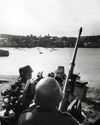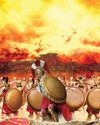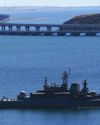Try GOLD - Free
JUNGLE WARRIORS
History of War
|Issue 148
The final victory in Burma came in no small part thanks to a series of special operations behind enemy lines, and in particular the actions of one British Army officer
Two Japanese sentries came within 150ft (45m) of where they were laid up, and at least four positions had been observed, but they had orders not to open fire until the main attack went in. Consequently, the men were probably a bit bored, waiting for what seemed like an interminable time, especially as the night drew swiftly in. The dark and the jungle may have put other men on edge, but these men remained comfortable but alert, watching, patient.
Below them, the Yu River joined the mighty Chindwin, and they observed fires made by the enemy on both sides of the river. It was the night of 14 January 1944, and these soldiers belonged to P Force. The 'P' stood for Peacock, the officer in charge of this irregular unit.
An imposing man, Major Edgar Peacock stood over six feet (182cm) tall and was well built. He had led P Force since March 1943, when he had arrived at Imphal, near the Indo-Burmese border. Finally, he was going to where he believed he would be most useful to the war effort; he was going back to the jungles and forests of Burma, a place he knew intimately.
Peacock had first arrived in Burma in 1914, fresh from forestry college at Dehra Dun in India. Becoming a forest warden meant that, much to his consternation, he was unable to sign up when the First World War began shortly after taking his posting in Burma. The next 18 years of his career in forestry and as a game warden took him all over the country, from Mawlaik up on the Chindwin to Mergui down in the long tail of Burma on the Andaman Sea. He knew the people of this land, he knew the languages and the culture, and he thrived in its remote jungly environments.
Return to Burma
 Getting back to Burma had taken some time and effort.
Getting back to Burma had taken some time and effort.This story is from the Issue 148 edition of History of War.
Subscribe to Magzter GOLD to access thousands of curated premium stories, and 10,000+ magazines and newspapers.
Already a subscriber? Sign In
MORE STORIES FROM History of War

History of War
BATTLE FOR THE CHANNEL ISLANDS
In 1945, the Allies were ready with a daring amphibious operation to liberate Jersey and Guernsey by force
8 mins
Issue 152

History of War
THE BOYNE
Three crowns were on the line when two kings met in Ireland on a sweltering summer's day
11 mins
Issue 152

History of War
PARIS DAVIS
This pioneering member of the United States Army Special Forces received long-overdue recognition for his heroism rescuing comrades during the Vietnam War
6 mins
Issue 152

History of War
FALL OF THE SPARTANS
The powerful Greek city-state overreached itself and saw its influence decline as it failed to integrate conquered territories
4 mins
Issue 152

History of War
MASTERS OF THE SKIES
From rapidly evolving roles to new technologies, historian and airpower expert John Curatola discusses how fighter planes shaped the Second World War
9 mins
Issue 152

History of War
TEA WITH TRAITORS
A progressive educator celebrated her birthday with a tea party for dissident friends – unaware that a Gestapo informant was among them
9 mins
Issue 152

History of War
CHURCHILL IN THE TRENCHES
How Britain's future war leader earned respect and redemption on the Western Front
13 mins
Issue 152

History of War
"MORE DANGEROUS THAN THE 1950S"
Do we need to relearn the Cold War's fear of mutually assured destruction in our unregulated nuclear landscape?
3 mins
Issue 152

History of War
CRIMEA IN THE CROSSHAIRS
The Black Sea peninsular has been coveted by rival interests for centuries, with the current Russian occupation motivated by several factors
5 mins
Issue 152

History of War
ON THE BRINK
Any conflict between the US and China would almost certainly see the American mainland come under direct attack
3 mins
Issue 152
Listen
Translate
Change font size
